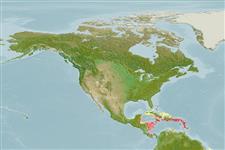Teleostei (teleosts) >
Blenniiformes (Blennies) >
Labrisomidae (Labrisomids)
Etymology: smithvanizi: Named in honor of William F. Smith-Vaniz in recognition of his many contributions to our knowledge of the taxonomy of marine shorefishes and for collecting and photographing representatives of the new species at St. Croix (Ref. 50108).
Eponymy: Edwin Chapin Starks (1867–1932) was an American ichthyologist who was an authority on the osteology of fish. [...] Dr William Farr ‘Bill’ Smith-Vaniz (d: 1941) is a Research Associate of the Florida Museum of Natural History, researching into the diversity and evolutionary relationships of fishes. [...] (Ref. 128868), visit book page.
Environment: milieu / climate zone / depth range / distribution range
Ecology
Marine; reef-associated; depth range 0 - 6 m (Ref. 50108). Tropical
Western Central Atlantic: Puerto Rico (Ref. 51183), Navassa Island, St. Croix, St. Barthelemy, and Dominica.
Size / Weight / Age
Maturity: Lm ? range ? - ? cm
Max length : 2.0 cm SL male/unsexed; (Ref. 50108)
Found only around islands (Ref. 51183).
Life cycle and mating behavior
Maturity | Reproduction | Spawning | Eggs | Fecundity | Larvae
Wiliams, J.T. and J.H. Mounts, 2003. Descriptions of six new Caribbean fish species in the genus Starksia (Labrisomidae). aqua, J. Ichthyol. Aquat. Biol. 6(4):145-164. (Ref. 50108)
IUCN Red List Status (Ref. 130435: Version 2024-2)
Threat to humans
Harmless
Human uses
Fisheries: of no interest
Tools
Special reports
Download XML
Internet sources
Estimates based on models
Preferred temperature (Ref.
123201): 27.4 - 28.1, mean 27.8 °C (based on 136 cells).
Phylogenetic diversity index (Ref.
82804): PD
50 = 0.5000 [Uniqueness, from 0.5 = low to 2.0 = high].
Bayesian length-weight: a=0.01000 (0.00244 - 0.04107), b=3.04 (2.81 - 3.27), in cm total length, based on all LWR estimates for this body shape (Ref.
93245).
Trophic level (Ref.
69278): 3.1 ±0.3 se; based on size and trophs of closest relatives
Fishing Vulnerability (Ref.
59153): Low vulnerability (10 of 100).
